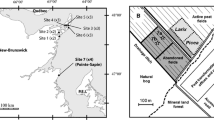Abstract
Exploitation of peatlands results in the degradation of hydrophysical conditions suitable for the re-establishment of peat-forming vegetation, notablySphagnum mosses. Regeneration of peat-forming mosses necessitates a high and stable water table. The objective of this study was to evaluate the performance of open water reservoirs constructed to improve the hydrologic conditions required for growth ofSphagnum. A section of abandoned peatland, where former drainage ditches have been blocked, was treated by excavating reservoir ditches at 3-, 5-, and 8-m intervals to increase the local water storage. The colonization ofSphagnum fuscum andS. angustifolium diaspores scattered on the experimental baulks between the reservoir ditches was measured. Results indicate that water storage increased at the experimental site. The water table was higher and more stable, with an average maximum depth of 0.46 m at the rewetted site compared to 0.55 m at the control site. The volumetric moisture content of the surface peat was improved by rewetting, showing an average of 62% compared to 55% at the control site. Negative soil water tension at the −0.1 m depth was ameliorated at the experimental sites and nearly eliminated where 5-m experimental ditch-reservoir spacing was employed.Sphagnum establishment was successful on all experimental baulks, showing a higher percentage cover where soil moisture was more readily available.
Similar content being viewed by others
Literature Cited
Beets, C. P. 1992. The relation between the area of open water in bog remmants and storage capacity with resulting guidelines for bog restoration. p. 133–140.In O. M. Bragg, P. D. Hulme, H. A. P. Ingram, and R. A. Robertson (eds.) Peatland Ecosystems and Man: An Impact Assessment. British Ecological Society and The International Peat Society (publishers), Dep. of Biolgoical Sciences, University of Dundee, UK.
Blankenburg, J. and W. Schafer. 1992. Hydrologic reaction of raised bogs to peat cutting, p. 118–124.In O. M. Bragg, P. D. Hulme, H. A. P. Ingram, and R. A. Robertson (eds.) Peatland Ecosystems and Man: An Impact Assessment. British Ecological Society and The International Peat Society (publishers), Dep. of Biological Sciences, University of Dundee, UK.
Eggelsmann, R. 1988. Rewetting for protection and renaturation/ regeneration of peatlands after or without peat winning. p. 251–260.In 8th International Peat Congress, Leningrad, Russia.
Eggelsmann, R. and J. Schwaar. 1979. Regeneration, recreation and renascence of peatlands in Northwestern Germany, p. 267–272.In Proceedings of the International Symposium on Classification of Peat and Peatlands. Hyytiala, Finland.
Environment Canada. 1993. Canadian climate normals 1961–90. Atmospheric Environment Service, Ottawa, ON, Canada.
Ingram, H. A. P. 1978. Soil layer in mires: function and terminology. Journal of Soil Science 29:224–227.
Inoue, T., Y. Umeda, and T. Nagasawa. 1992. Some experiments restoring hydrologic conditions of peatland in Hokkaido, Japan, p. 196–203.In T. Younos, P. Diplas, and S. Mostaghimi (eds.) Land Reclamation: Advances in Research and Technology. Proceedings of the International Symposium. Nashville, TN, USA.
Lasalle, P. 1968. Excursion géologique du Quaternaire Saguenay Lac Saint-Jean. p. 31.In Contribution au Congrès de l’ACFAS. 6–7 September 1968. Ministère des richesses naturelles du Québec, Canada.
Lavoie, C. and L. Rochefort. 1996. The natural revegetation of a harvested peatland in southern Québec: A spatial and dendroecological analysis. Écoscience 3:101–111.
Mawby, F. J. 1995. Effects of damming peat cuttings on Glasson Moss Wedholme Flow, two lowland raised bogs in Northwest England, p. 349–357.In B. D. Wheeler, S. C. Shaw, W. Fojt, and R. A. Robertson (eds.) Restoration of Temperate Wetlands. John Wiley and Sons, Chichester, UK.
Meade, R. 1992. Some early changes following the rewetting of a vegetated cutover peatland surface at Danes Moss, Cheshire, UK, and their relevance to conservation management. Biological Conservation 61:31–40.
Monenco Ontario Limited. 1981. Evaluation of the potential of peat in Ontario. Ontario Ministry of Natural Resources, Mineral Resources Branch, Occasional Paper No. 7. Toronto, ON, Canada.
Nick, K. J. 1984. Measures and chances of success for the regeneration of bogs after the complete industrial cutting of peat. p. 331–338.In Proceedings: 7th International Peat Congress. The Irish National Peat Committee and The International Peat Society, Dublin, Ireland.
Okruszko, H. 1995. Influence of hydrologic differentiation of fens on their transformation after dehydration and on possibilities for restoration. p. 113–119.In B. D. Wheeler, S. C. Shaw, W. Fojt, and R. A. Robertson (eds.) Restoration of Temperate Wetlands. John Wiley and Sons, Chichester, UK.
Price, J. S. 1991. Evaporation from a blanket bog in a foggy coastal environment. Boundary-Layer Meteorology 57:391–406.
Price, J. S. 1996. Hydrology and micro climate of a partly restored cutover bog, Québec. Hydrologíc Processes 10:1263–1272.
Quinty, F. and L. Rochefort. 1997. Plant re-introduction on a harvested peat bog. p. 133–145.In C. C. Trettin, M. F. Jurgensen, D. F. Grigal, M. R. Gale, and J. K. Jeglum (eds.) Northern Forested Wetlands: Ecology and Management. CRC/Lewis Publishers, Boca Raton, FL, USA.
Rochefort, L., R. Gauthier, and D. LeQuéré. 1995. Sphagnum regeneration—toward an optimisation of bog restoration. p. 423–434.In B. D. Wheeler, S. C. Shaw, W. Fojt, and R. A. Robertson (eds.) Restoration of Temperate Wetlands. John Wiley and Sons, Chichester, UK.
Rochefort, L., F. Quinty, and S. Campeau. 1997. Restoration of peatland vegetation: the case of damaged or completely removed acrotelm. International Peat Journal 7, in press.
Rubec, C. 1996. The status of peatland resources in Canada. p. 243–252.In E. Lappalainen (ed.) Global Peat Resources. International Peat Society, Jyskä, Finland.
Sagot, C. and L. Rochefort. 1996. Tolérance des sphaignes à la dessiccation. Cryptogamie, Bryologie et Lichénologie 17:171–183.
Schothorst, C. J. 1977. Subsidence of low moor peat soil in the western Netherlands. Geoderma 17:265–291.
Schouwenaars, J. M. 1988. The impact of water management upon groundwater fluctuations in a disturbed bog relict. Agricultural Water Management 14:439–449.
Schouwenaars, J. M. 1992. Hydrologic characteristics of bog relicts in the Engbertsdijksvenen after peat-cutting and rewetting, p. 125–132.In O. M. Bragg, P. D. Hulme, H. A. P. Ingram, and R. A. Robertson (eds.) Peatland Ecosystems and Man: An Impact Assessment. British Ecological Society and The International Peat Society, Department of Biological Sciences, University of Dundee, UK.
Schouwenaars, J. M. 1993. Hydrologic differences between bogs and bog-relicts and consequences for bog restoration. Hydrobiologia 265:217–224.
Schouwenaars, J. M. 1995. The selection of internal and external water management options for bog restoration. p. 331–346.In B. D. Wheeler, S. C. Shaw, W. Fojt, and R. A. Robertson (eds.) Restoration of Temperate Wetlands. John Wiley and Sons, Chichester, UK.
Vasander, H. A., A. Leivo, and T. Tanninen. 1992. Rehabilitation of a drained peatland area in the Seiseminen National Park in Southern Finland. p. 381–387.In O. M. Bragg, P. D. Hulme, H. A. P. Ingram, and R. A. Robertson (eds.) Peatland Ecosystems and Man: An Impact Assessment. British Ecological Society and The International Peat Society, Department of Biological Sciences, University of Dundee, UK.
Verry, E. S. 1984. Microtopography and water-table fluctuation in aSphagnum mire. p. 11–31.In Proceedings: 7th International Peat Congress. The Irish National Peat Committee and The International Peat Society. Dublin, Ireland.
Wheeler, B. D. and S. C. Shaw. 1995. Restoration of Damaged Peatlands, HMSO, London, UK.
Author information
Authors and Affiliations
Rights and permissions
About this article
Cite this article
LaRose, S., Price, J. & Rochefort, L. Rewetting of a cutover peatland: Hydrologic assessment. Wetlands 17, 416–423 (1997). https://doi.org/10.1007/BF03161431
Received:
Revised:
Accepted:
Issue Date:
DOI: https://doi.org/10.1007/BF03161431




